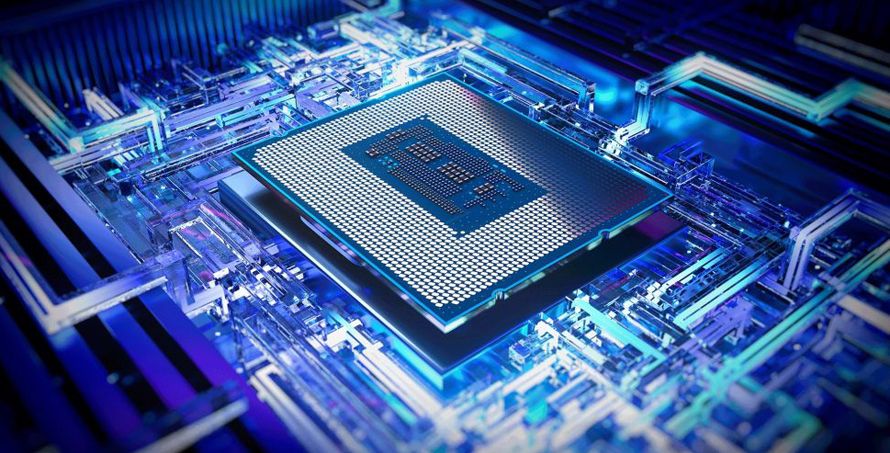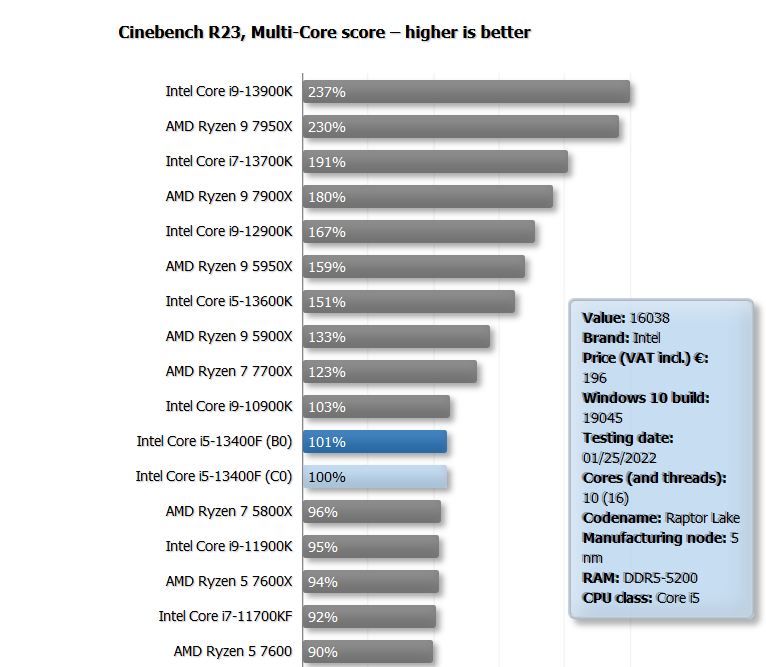
Raptor and Alder Lake Flavors of Intel’s Core i5-13400F Perform About the Same
With the introduction of the non-K 13th Gen Raptor Lake CPU lineup, Intel started to mix and match Raptor Lake and Alder Lake dies into its latest generation of Intel Core CPUs. However, how much faster Raptor Lake versions might be over Alder Lake counterparts remained a mystery until now.
HWCooling.net has acquired Alder and Raptor Lake versions of the i5-13400F CPUs and benchmarked them. It appears the performance gap is almost non-existent, with a 5% performance difference at best between the two versions in real-world, synthetic, and gaming benchmarks.
We’ve known for a while that Intel would reuse its Alder Lake CPU architecture with some of its latest 13th Gen non-K Raptor Lake processors to improve yields and reduce waste. In the case of the i5-13400F, Intel accomplished this strategy by re-purposing i9-12900/12900K dies into i5-13400 CPUs by disabling some of the P-cores and the CPU cache.
According to HWCooling, the Raptor Lake version goes by stepping B0, while the Alder Lake one is stepping C0. However, the stepping number is not printed on the physical chip, so if you want to identify these chips, you have to check out the S-Spec code, which is SRMBG on the Raptor Lake i5-13400F and SRMBN on the Alder Lake counterpart.
Unfortunately, the Raptor Lake version is almost impossible to find in retail circles. HWCooling says that virtually all retail i5-13400Fs are the Alder Lake version, while the Raptor Lake models are found in the OEM market.
Performance, Clock Speed, and Power Consumption Tests

Both flavors of the i5-13400F were tested in several CPU benchmarks, including Cinebench R23, FLAC, and F1 2020. The chips were neck and neck with each other in nearly all benchmark tests, with a maximum performance delta of 5%. In Cinebench R23, for example, the Raptor Lake i5-13400F scored 16,131 points in the multi-core test, while the Alder Lake version scored 16,038 points — a 0.6% difference in score.
F1 2020 saw a bit more variance, with the Raptor Lake chip leading its Alder Lake counterpart by 5%, with an average frame rate of 325.8 frames per second (fps) to the Alder Lake’s 311.4fps. Minimums were more significant, though, with the Raptor Lake version edging out the Alder Lake version by 10%: 258.5fps vs. 234.7fps.
However, not all games were this sensitive to the Raptor Lake architecture. Shadow of the Tomb Raider was also tested and showed identical frame rate numbers between the two chips.
Both chips demonstrated similar memory and cache performance. AIDA64 showed nearly identical read, write, and latency performance between the two versions. The only exception was the L2 cache performance, where the Raptor Lake chip was 33.3% quicker than the Alder Lake version — but HWCooling said this was a reporting issue by AIDA64, so these results may not be accurate.
The most interesting results were the power consumption numbers. The Raptor Lake i5-13400F was less efficient than the Alder Lake version in most tests, except for the FLAC results. In Cinebench R23, the Raptor Lake part consumed 14% more power, averaging 115W to the Alder Lake’s 95W. However, the efficiency differences were much less severe while gaming: in F1 202, the Raptor Lake version averaged 55W to the Alder Lake’s 52W, which means it was only 5.7% less efficient. Power efficiency results were similar across other games.
Interestingly, the FLAC audio recording results did not exhibit the same power consumption behavior. In this test, the Raptor Lake version was 42% more efficient than the Alder Lake version, pulling 18.5W vs. the Alder Lake’s 26.17W.
Clock speeds between the two parts were identical. Average core clocks on the P-cores max out at 4.1GHz and 3.3GHz on the E-cores during an all-core workload. During single-core workloads, the P-cores average 4.58GHz and 3.3Ghz on the E-Cores. Intel had to keep clock speeds equal here, or it would be forced to part out the Raptor Lake i5-13400F with a different model name.
Thankfully, there are barely any differences between Raptor Lake and Alder Lake versions of the i5-13400F. Both models exhibit nearly identical performance figures even though one version operates on a newer architecture. This boils down to the fact both CPU versions are artificially limited to the same clock speeds, preventing Raptor Lake’s higher clock speed potential from being used (and you can no longer bypass this limit with overclocking).
If you’re on the market for an Intel i5-13400F, you can rest assured knowing you won’t be sacrificing any noticeable performance by going with the Alder Lake version.